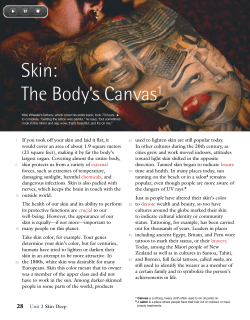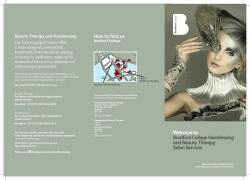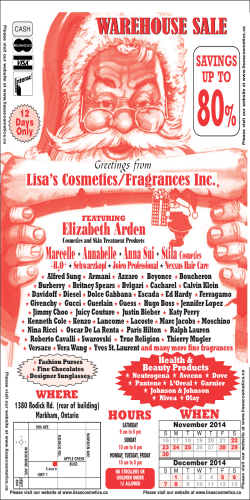
Ideals of Beauty and Body Modification Martin T Donohoe, MD, FACP
Ideals of Beauty and Body Modification Martin T Donohoe, MD, FACP Historical Ideals of Beauty • Ancient Greeks valued symmetry • Contemporary definitions similar: – “Ideal woman”: small chin, delicate jaws, full lips, small nose, high cheek bones, large and widely spaced eyes, and waist:hip ratio of 0.7 – “Ideal man”: taller, waist:hip ratio of 0.9, dominant/rectangular face/chin, deep-set eyes, heavy brow • Suggests strong supply of testosterone “Ugly” • Common first name in Ancient Greece, parts of sub-Saharan Africa • Idea: give children bad names so demons won’t find them • Other favorites: “Disagreeable,” “Crippled” Historical Ideals of Beauty • Scarification – dates back at least 4,000 years • Chinese foot binding – pain, osteoporosis, falls/imbalance – Surgery to reshape women’s feet for stiletto heels increasingly popular • Ancient Greek newborn female baby wrapping Historical Ideals of Beauty • Ancient Roman women colored their lips with red cinnabar stone, a type of mercury ore, lined their faces with white lead, and rouged their cheeks with red lead • Ancient Egyptians/Roman/Persians: antimony for conjunctival sparkle • Rome to medieval Europe: paleness preferred Historical Ideals of Beauty • Renaissance women used leeches on their ears to drain blood from their faces for a fashionably pale complexion • Elizabethan hair plucking, ceruse makeup • Elizabethans used lard to set wigs, which could result in rat infestations Historical Ideals of Beauty • Court of Louis XVI: blue veins drawn on neck and shoulders to emphasize noble blood • 16th & 17th century: belladona eye drops Historical Ideals of Beauty • 18th Century: vermillion makeup (sulfur and mercury) • 14th - 19th century: corsetting (whalebone and steel) – precursor to the girdle/Spanx – Making a comeback at both high- and lowend retailers (takes up to 30 minutes to lace up; requires an extra set of hands) Historical Ideals of Beauty • Unibrow: – Sign of criminal tendencies in Victorian England; mark of beauty in contemporary Iran • 19th Century: Vacuum pumps and vibration therapy for baldness/”flabby skin”; mercury-based freckle remover Historical Ideals of Beauty • Efik people of the Nigerian coast, others: fattening rituals • Breast implants (since 1903 Charles Miller, MD) –First silicone breast enlargement 1962 Contemporary Ideals of Beauty • “Better Baby Contests” – Eugenic Movement / Social Darwinism – Today – “Baby Bangs” • Tapeworms (Maria Callas) • Rib removal (Cher?) • Prostitutes using diuretics (for weight loss), child sex workers forced to take dexamethasone (to look older, “curvier”) Contemporary Ideals of Beauty • Botox injections • Plastic surgery • Abusive subjugation of women through body modification – female genital mutilation – Cultural components Ideals of Beauty • Brass neck rings (Paduang people of Burma) • Lip and earlobe expanders (certain African tribes) • Tattoos, body piercings, wings Ideals of Beauty • Wonderbra, Brava Bra ($2500, suction device worn overnight for 10 weeks, promises 1 cup increase (actual increase ½ cup size), can cause broken blood vessels, skin rash, discomfort) • Wonderbum pantyhose (DuPont Lycra) – promises a “perfectly peachy, pert bottom” • Music industry depictions of beauty Ideals of Beauty • Ancient Greeks – symmetry – Remains true – Familiarity, personality traits also important • Evolutionary adaptation for survival of human species – Size, muscle power, pathogen-free status, fertility The Perks of Beauty • The good-looking are more likely to have higher self-esteem, date more, get higher grades, graduate from college, get married, be hired, get paid more (including tips), and be promoted sooner • Lifetime earnings difference between the typical “good-looking” and “below average-looking” worker = $230,000 The Perks of Beauty • Height is associated with income and leadership positions – Ironically, 50 years ago some women were treated with estrogen to prevent them from growing too tall and becoming unmarriable – This impaired their fertility, among other consequences • Strangers are more likely to assist good-looking people in distress The Perks of Beauty • The pretty/handsome are less likely to be reported, caught, accused, or punished for a minor or major crime • Role of ageism (more important for women) • The responsibility: – Attractiveness is recognized as a special gift, and its misuse is not tolerated The Adonis Complex • 38% of men want bigger pectorals; 34% of women want bigger breasts • Each year, men spend over $2 billion on health club memberships and $2 billion for home exercise equipment • Tommy John surgery – To enhance elbow strength and improve pitching velocity Anabolic Steroid Abuse • Supplement industry booming • 3 million American men have swallowed or injected anabolic steroids since they became widely available in the 1960s Anabolic Steroid Abuse • 5.9% of current middle and high school students have used anabolic steroids (100% increase over last 6 years); rates higher among boys – Use associated with violent behavior • 35% use protein powders/shakes to build muscle Adonis Complex of the Middle Aged and Elderly • “Low T (testosterone) Syndrome” • Hypogonadism is a real disorder, but “Low T Syndrome” manufactured by drug companies to treat those with stunted libidos and depressed mood – “Treatment” carries increased risk of cardiovascular disease, BPH, prostate cancer Cosmetics • Concocted at home prior to 20th Century • Industry spawned by: – “Allure” of prostitutes/sexuality – Mass popularity of anti-aging products in 1920s – Women entering workforce – Migrations to cities • Food, Drug and Cosmetic Act (1938) Cosmetics • Worldwide annual spending around $19 billion ($8 billion in US) – 33% more than the amount needed each year (in addition to current expenditures) to provide water and sanitation for all people in developing nations – Slightly more than the amount needed each year (in addition to current expenditures) to provide reproductive healthcare for all women in developing countries Cosmetics • Average American adult uses 9 personal care products/day (with 126 unique chemical ingredients) –89% of the over 10,500 ingredients used in personal care products never tested for toxicity –Little FDA oversight Cosmetics • Most contain carcinogens and/or endocrine disruptors (see http://www.cosmeticsdatabase.com/) • Unusual/dangerous ingredients include: – Mercury – skin creams – Lead – lipstick and kohl (decorative black eyeliner, alleged to help children’s eyes develop and protect them against curses) – Arsenic, Cadmium, Copper, aluminum – Bacteria – mascara Cosmetics • Unusual/dangerous ingredients include: – Mica (lung-damaging particles) – Cow colostrum – Gold – Foreskin – Placenta/Fetal cells – Paint stripper and varnish - eyeliner Cosmetics and Hair Coloring • Women devote average of 19 minutes per day to treating and altering their faces • 55% of American women between 13 and 70 color their hair –1/8 American men between 16 and 60 Hair Care Products • African-American “hair relaxers” contain endocrine disruptors – Use increases risk of uterine fibroids, cancers • Brazilian Blowout hair straightening products contain formaldehyde (possible carcinogen) Cosmetics • 2013: EU bans sale of all cosmetics tested on animals Tanning • The skin’s response to ultraviolet light injury • No such thing as a “safe tan” • 95% of Americans understand that sunburns are dangerous, but 81% still think they look better with a tan. Tanning • UVA and UVB dangerous • Ozone damage allows greater UV radiation exposure – Estimated lifetime risk of melanoma 1/70 • Clouds filter out only 20% of sun’s UV rays • Snow reflects up to 80% of UV rays (sand 17%) • White T-shirt has SPF 7 (min 15 recommended); darker shirts have higher SPFs Artificial Tanning • 36% of adults, 25% of teens, and 55% of college students use a tanning lamp each year (females more than males) • More than 90% of users are aware that premature aging and skin cancer are possible complications of tanning lamp use (melanoma and basal cell) Artificial Tanning • WHO: tanning beds cause cancer – 419,000 cases of basal and squamous cell skin cancer and 11,000 cases of melanoma each year attributable to indoor tanning • Skin cancers of all types rising: 1/5 Americans will get during their lifetimes Tanning Facilities • Over 50,000 in US (more than the number of Starbucks or McDonalds) • Generate revenues of over $5 billion/yr Tanning Facilities • Most countries do not limit access of youths to tanning parlors • Most US states limit access of youths (bans; parental consent) • FDA advisory panel has recommended increased regulation, including restricting use to adults • Indoor 10% tanning tax implemented in 2010 as part of PPACA (Obama Health Care Plan) Tanning • Tanning as a substance abuse-like disorder – Associated with other addictions • Tanning produces endorphins – some contain fragrances – can cause allergic reactions – Sprays may damage lungs Tanning • Mineral sunscreens best (Zn or Titanium); lotions and creams do not necessarily protect against UVA) • Use SPF of at least 15 and re-apply frequently – Avoid benzophenone (aka oxybenzone, estrogenic); avobenzone is safer Artificial Tanning • Many lotions, creams, and sprays available – Most contain dihydroxyacetone (DHA) – can damage DNA and lungs and cause allergic reactions • Burgeoning industry • “Natural” does not necessarily mean safe • See EWG database Artificial Tanning • Increased (but not excessive) carotenoidcontaining fruit and vegetable consumption can improve skin color • Tanning pills (not approved for use) containing canthaxanthin dangerous • Skin lightening creams may contain mercury Tattooing • Roman Empire used to brand convicts, slaves, and army deserters • Tattoo from Tahitian word “tatau” (“to mark”) • Reached apogee among Maori • Popularized in West by sailors returning from Polynesia Tattooing • Aesthetic choice • Initiation rite • Time-saving way for disabled to overcome difficulties of applying makeup • Adjuvant to reconstructive surgery (particularly face and breast, to simulate natural pigmentation) Tattooing • 30 million Americans have tattoos – 40% of Americans between 26 and 40 • Ancient practice: Maori tribesmen, Thracian women of 5th Century Greece, Moors) • Tattooing still illegal in South Carolina and Oklahoma Tattooing • More than 50 different pigments and inks employed – Many contain heavy metals, phthalates, other endocrine disruptors and carcinogens – Some contain industrial grade printer’s ink or automobile paint Tattooing • FDA considers inks to be cosmetics (premarketing safety evaluation required) • FDA considers pigments to be “color additives” (no premarketing safety evaluation required) Risks of Tattooing • Tattooing associated with risky behaviors in adolescents • Infection – e.g., Staph, Strep, Mycobacteria, hepatitis B, C, and HIV (HIV risk theoretical – no cases identified to date) – Am Assn Blood Banks requires one-year wait between getting tattoo and donating blood • Allergic reactions Risks of Tattooing • • • • • Granulomas Keloid formation MRI complications Swellings/burns Image quality suffers (particularly with permanent mascara) • Removal problems The Most Common Problem: Dissatisfaction • > 1/3 of those tattooed later regret it – Chief reason = the person’s name in the tattoo • Practitioners’ skill levels vary widely • Fading with time • Blurring when injections too deep The Most Common Problem: Dissatisfaction • Human body changes with time • Styles come and go • With facial cosmetic surgery, appearance of tattoos and permanent makeup may become distorted Tattoo Removal Techniques • Laser treatments (photothermolysis) – Requires multiple treatments • • • • • Dermabrasion Salabrasion Scarification Surgical Removal Camouflaging Temporary Tattoos • Fade after several days • Allergic reactions • FDA alert re risks with foreign-made products • Freedom-2 Ink, Infinitink: Biodegradable dye capsules – when zapped by laser, dyes absorbed by body and tattoo disappears Risks of Henna Tattoos • Henna products risky – Henna approved for use as a hair dye, not for injection into the skin – Produces a reddish-brown tint, raising questions about what ingredients are added to produce the varieties of colors labeled as henna (e.g., “black henna,” “blue henna” – Color can last for more than a week Body Piercing • 36% of Americans • Women > Men • Complications: 20-40% – Skin irritation and infections most common Body Piercing Complications • Other complications include auricular chondritis, nasal cartilage destruction, abscesses, contact dermatitis, bleeding, bladder infections, dental trauma, and other secondary trauma • Death rare • Avoid shopping mall kiosks • Unclear if prophylactic antibiotics helpful The Fringes • Snail slime facials to make skin soft (South America) • Nightingale dung facials to bleach and brighten skin (Japan, “The Geisha Facial”) • “Vampire Facelift”: patient’s own blood injected into face to smooth out wrinkles • Face slapping by massueses The Fringes • Merkins (pubic hair wigs – used throughout history – allow male actors to play females; hide STDs; decorative; etc.) • Pubic hair implants (abundant pubic hair associated with fertility in South Korea) The Fringes • Anal bleaching – Initially porn stars and sex workers – Now available to general public for $75/treatment – Can cause eczema • Red labial dye (“My New Pink Button”) The Fringes • Money: Jim Nelson auctioned off his head on eBay for a corporate logo tattoo in 2003 • Others sell tattoo space on their bodies Botox • Botulinum toxin: – Cause of botulism – potential biowarfare/bioterror agent • Medical Uses: blepharospasm, spasmodic torticollis, migraines, back spasms, chronic pain, axillary hyperhidrosis, BPH, autonomic disorders, wrinkles due to normal aging • Unlikely to work on sun- or smoking-induced wrinkles Botox • Manufacturer = Allergan – Allergan also markets Latisse (bimatoprost, the same ingredient in the glaucoma treatment Lumigan) for topical “treatment” of “hypertrichosis of the eyelashes” (eyelash transplant alternative) – Myobloc, Dysport, and Xeomin (other botulinum neurotoxins) – -Limited standardization Botox • 4.8 million procedures in 2009 • Large direct-to-consumer ad campaign – Olympians Mark Spitz, Nadia Comanici involved • $80/dose + physician’s fee ($443 avg.) Botox • Most users white, age 35-50 • 12% are men • In-home Botox parties; Botox scams; counterfeit Botox (ineffective and/or dangerous) • Hollywood actors Botox • Retreatments required q 3-4 months • Side effects: muscle weakness, masklike facies, drooling, slurred speech, aspiration, dysphagia, dysnpnea, rare allergic reactions; may spread via neurons back to spinal cord or even CNS – 87 hospitalizations, 16 deaths reported 1997-2006 – FDA boxed warning 2009 Rivals to Botox • Collagen injections (from cows, possible allergic responses) • Perlane (“natural” collagen alternative from human tissue) • Fat injections • Face lift/eyelid surgery Dermal Fillers • Alternative to botox • Cow collagen, liquid silicone, plastic microbeads, synthetic bone and ground-up human cadaver skin (association with for-profit tissue banks) Dermal Fillers • $700-$900 per treatment (lasts a few months) – Compare with $4000-$6000 for a facelift, which lasts 10-15 yrs before requiring touch-ups • Risks – Include renal failure, retinal artery occlusion Conclusions • Ideals of beauty: some relatively constant, others change • Multiple methods of body modification: some dangerous, even abusive Covered in Other Slide Shows • Cosmetic surgery • Female genital cutting • Body weight and the obesity epidemic • Ethical and policy issues References • Donohoe MT. Beauty and body modification. Medscape Ob/Gyn and Women’s Health 2006;11(1): posted 4/19/06. Available at http://www.medscape.com/viewarticle/529442 • Donohoe MT. Cosmetic surgery past, present, and future: scope, ethics and policy. Medscape Ob/Gyn and Women’s Health 2006;11(2): posted 8/28/06. Available at http://www.medscape.com/viewarticle/542448 Re Tanning • See slide show by Anuru and Salmon on risks and regulations related to indoor tanning at http://phsj.org/?page_id=10 Contact Information Public Health and Social Justice Website http://www.phsj.org [email protected]
© Copyright 2025










